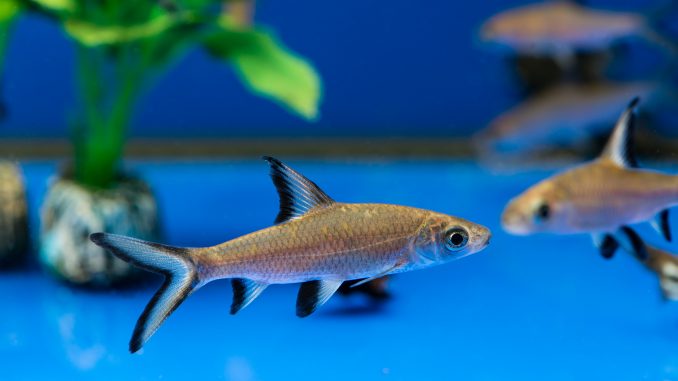
Freshwater sharks are minnows, carps, cyprinids, or catfish that have a shark-like appearance. Actual freshwater sharks are too large to be sold in the aquarium trade.
The fish on this list resemble (but are much smaller than) real freshwater sharks found in the wild.
Found in South America, Southeast Asia, Africa, and China, freshwater sharks are lively, entertaining fish with peaceful or semi-aggressive personalities.
Freshwater sharks are fairly common in the pet trade, but they aren’t as popular as other aquarium fish because freshwater sharks often need to be housed alone.
TABLE OF CONTENTS
Red Tail Shark
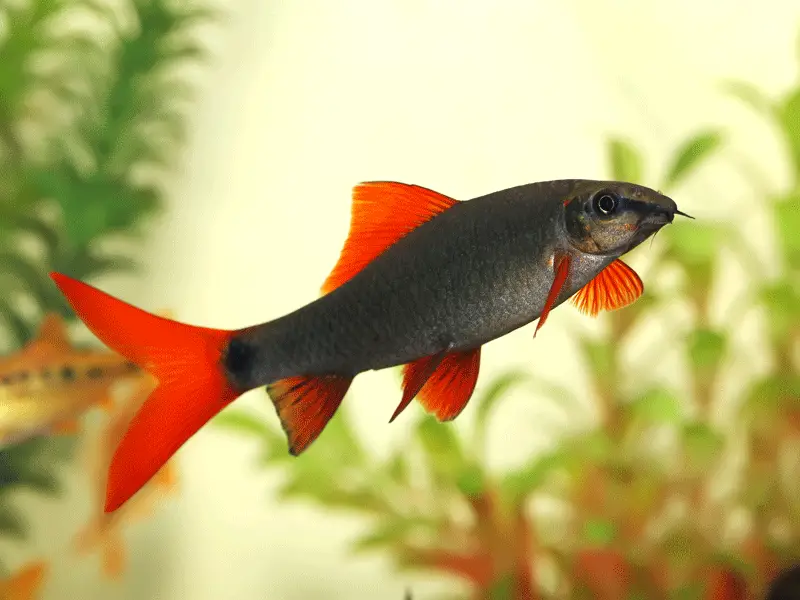
| Care level: | Temperament: | Color: | Lifespan: | Size: |
| Intermediate | Semi-aggressive | Black with a red or orange tail | 5–8 years | Up to 6 inches |
| Water temperature: | Water pH: | Tank size: | Diet: | Scientific name: |
| 72–79°F | 6.0–8.0 pH | 55 gallons | Omnivore | Epalzeorhynchos bicolor |
The red tail shark is a medium-sized freshwater species of carp originating from the Chao Phraya basin in Thailand. Red tail sharks are popular among aquarists due to their bright colors and lively personalities.
Red tail sharks have black bodies with red or orange tails. These hardy fish are easy to care for, but their feisty personalities and solitary natures make them difficult to introduce to a community tank.
House a red tail shark with medium-sized, top-dwelling boisterous fish that won’t be intimidated by the sharks. Giant danios, tiger barbs, and neon tetras make good tank mates for red tail sharks.
Harlequin Shark
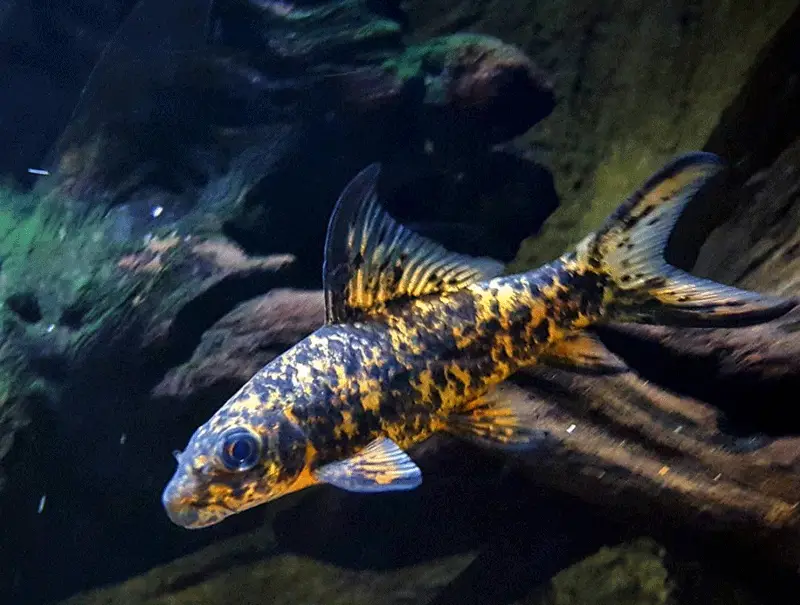
| Care level: | Temperament: | Color: | Lifespan: | Size: |
| Intermediate | Semi-aggressive | Yellow with mottled gray markings | 5–8 years | Up to 12 inches |
| Water temperature: | Water pH: | Tank size: | Diet: | Scientific name: |
| 70–81°F | 6.5–7.5 pH | 55 gallons | Omnivore | Ctenacis fehlmanni |
Harlequin sharks, or harlequin sharkminnows, are freshwater cyprinid fish found in the middle and lower Congo River basin in Africa. Harlequin sharks have a unique appearance that makes them a standout fish in any aquarium.
The harlequin shark has a creamy yellow body with gray and black mottling and black, translucent fins.
Due to their territorial natures, harlequin sharks require a large tank to reduce conflict.
House harlequin sharks with fish that match the harlequin’s temper, such as carps, danios, minnows, and barbs. Add harlequin sharks last to the tank.
Rainbow Shark
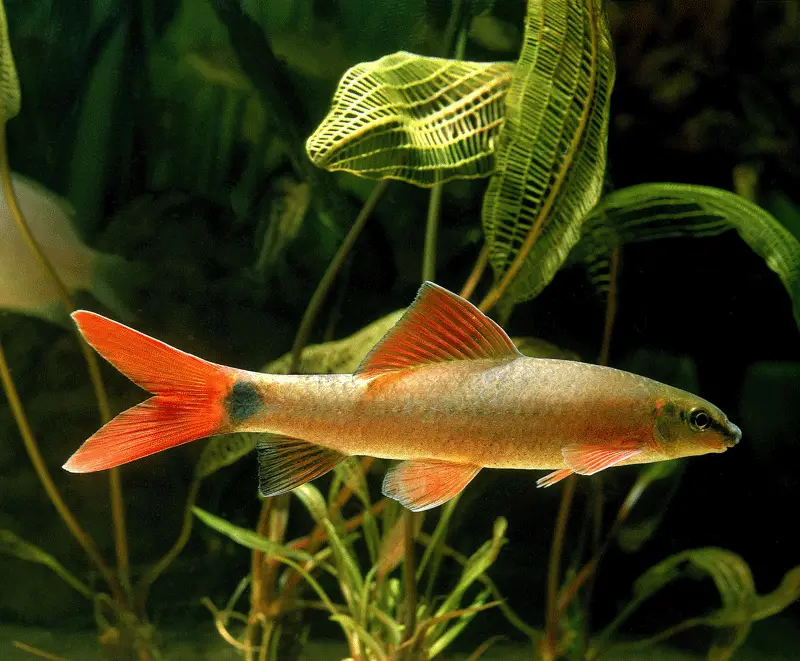
| Care level: | Temperament: | Color: | Lifespan: | Size: |
| Intermediate | Semi-aggressive | Gray, dark blue, or black, with red or orange fins | 5–8 years | 4–6 inches |
| Water temperature: | Water pH: | Tank size: | Diet: | Scientific name: |
| 72–79°F | 6.5–7.5 pH | 50 gallons | Omnivore | Epalzeorhynchos frenatum |
Rainbow sharks are red-finned fish from the minnow or carp family, found in Laos, Cambodia, Myanmar, Vietnam, and Thailand. The rainbow shark is popular with aquarists due to its unique appearance and active behavior.
The body of the rainbow shark is gray, blue, or black, and the fins are bright red or orange.
Rainbow sharks are semi-aggressive and territorial towards other fish, especially when housed in cramped tanks without enough open swimming space.
House rainbow sharks with fish that are calm and strong enough to defend themselves against rainbow sharks, such as danios, barbs, rasboras, and gouramis.
Violet Blushing Shark
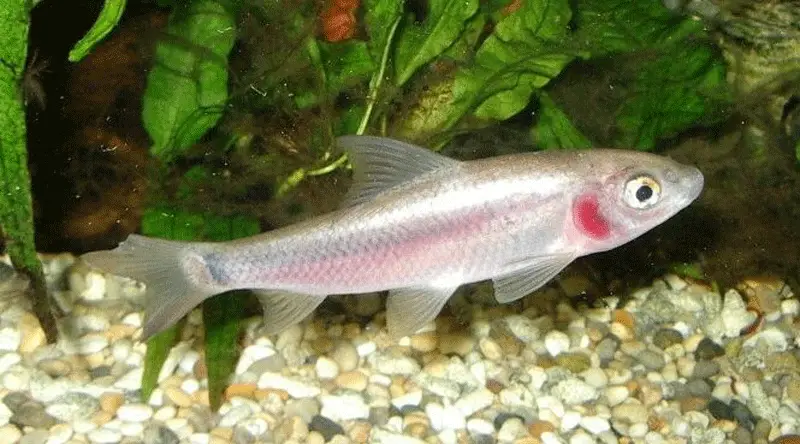
| Care level: | Temperament: | Color: | Lifespan: | Size: |
| Intermediate | Semi-aggressive | Pale white-pink with red or violet cheeks | Up to 10 years | Up to 12 inches |
| Water temperature: | Water pH: | Tank size: | Diet: | Scientific name: |
| 72–81°F | 6.0–7.5 pH | 125 gallons | Omnivore | Epalzeorhynchos bicolor |
Violet blushing sharks are medium-to-large freshwater fish belonging to the carp family, found in India, Nepal, Pakistan, Bangladesh, and Myanmar. Violet blushing sharks have a unique, almost colorless appearance that makes them a popular choice for white or albino fish tanks.
The violet blushing shark is so-called because of the red or violet markings on the fish’s cheeks. These markings are the only color on the fish’s otherwise pale body.
Violet blushing sharks have semi-aggressive personalities and should be housed in groups of at least six to reduce aggressive behavior.
House violet blushing sharks with medium-sized fish such as clown loaches, devarios, and rainbowfish.
Black Sharkminnow
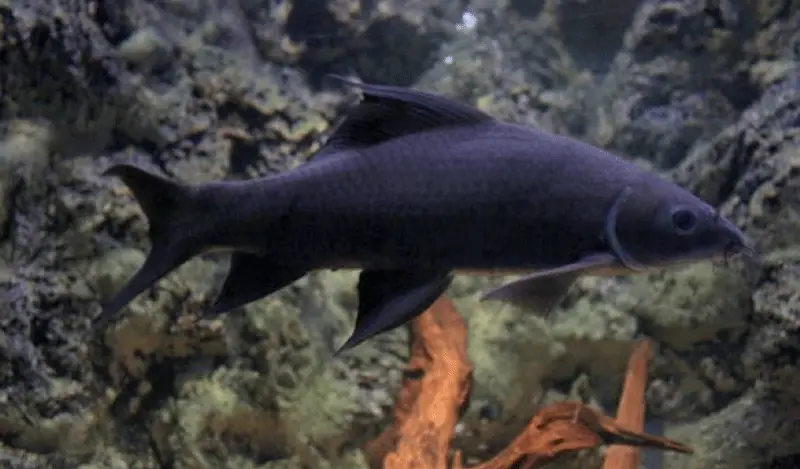
| Care level: | Temperament: | Color: | Lifespan: | Size: |
| Intermediate–advanced | Aggressive | Smoky black | 10–15 years | 30–35 inches |
| Water temperature: | Water pH: | Tank size: | Diet: | Scientific name: |
| 68–79°F | 6.5–7.5 pH | 200 gallons | Omnivore | Labeo chrysophekadion |
Black sharks, or black sharkminnows, are smoky black sharks from the carp family, originating from the Chao Phraya and Mekong river basins, Sumatra, Java, the Malay Peninsula, and Borneo.
Black sharkminnows are popular due to their unique coloring, but because of their large size, the fish aren’t suitable for all aquarium hobbyists.
Baby black sharkminnows are pure black, and the fish lighten to gray as they mature. Adult black sharkminnows grow to be more territorial and aggressive than juveniles, and require a tank size of at least 200 gallons.
Due to their territorial behavior, black sharkminnows are best housed with large community fish species, such as oscar fish and firemouth cichlids.
Roseline Shark
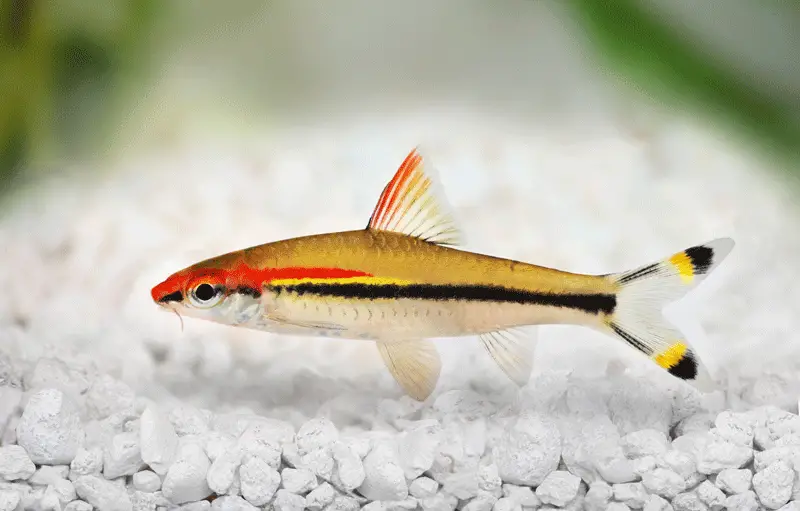
| Care level: | Temperament: | Color: | Lifespan: | Size: |
| Easy | Peaceful | Silver, yellow, and red | Up to 5 years | Up to 6 inches |
| Water temperature: | Water pH: | Tank size: | Diet: | Scientific name: |
| 60–77°F | 6.5–7.8 pH | 55 gallons | Omnivore | Sahyadria denisonii |
Roseline sharks, or denison barbs, are medium-sized, vibrant fish of the barb family, endemic to pools, streams, and rivers in India. These fish are popular among aquarists due to their peaceful personalities and beautiful colors.
The roseline shark’s base color is silvery gray, with a vibrant horizontal red streak spanning from the nose to the tail. Some roseline sharks have yellow base coloring that becomes brighter toward the tail.
Roseline sharks are sociable shoaling fish that should be housed in groups of at least six.
Good tank mates for roseline sharks are other peaceful, active swimmers, like yoyo loaches, kribensis cichlids, rosy barbs, and danios.
Silver Apollo Shark
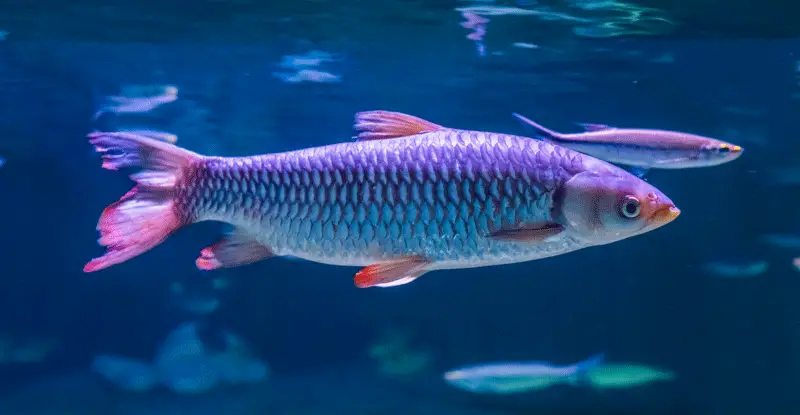
| Care level: | Temperament: | Color: | Lifespan: | Size: |
| Easy | Peaceful | Silver with a horizontal black stripe | Up to 14 years | Up to 10 inches |
| Water temperature: | Water pH: | Tank size: | Diet: | Scientific name: |
| 68–77°F | 6.0–6.5 pH | 125 gallons | Omnivore | Luciosoma spilopleura |
The silver apollo shark is a medium fish from the carp family. This fish is found in fast-flowing rivers and streams in Thailand, Vietnam, Cambodia, Laos, Indonesia, and Malaysia. Silver apollo sharks are popular due to their peaceful, active personalities.
Silver apollo sharks have silver bodies with a horizontal black stripe from eye to tail. In some silver apollo sharks, a yellow horizontal stripe sits on top of the black stripe.
Silver apollo sharks have calm personalities and are easy to look after.
House silver apollo sharks with peaceful, lively fish, like clown loaches, dwarf cichlids, and honey gouramis.
Bala Shark
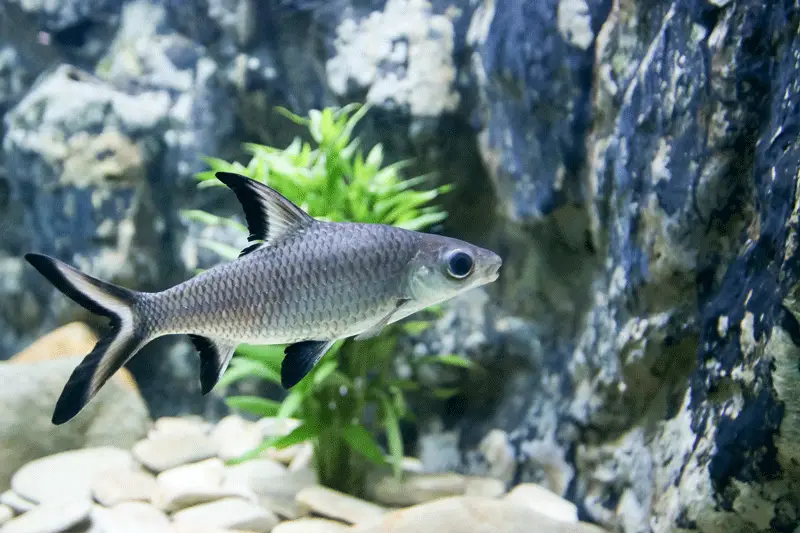
| Care level: | Temperament: | Color: | Lifespan: | Size: |
| Easy | Peaceful | Black, silver, and yellow | Up to 10 years | Up to 14 inches |
| Water temperature: | Water pH: | Tank size: | Diet: | Scientific name: |
| 72–82°F | 6.0–8.0 pH | 120 gallons | Omnivore | Balantiocheilos melanopterus |
Bala sharks are uniquely shaped fish from the minnow and carp family, hailing from the freshwater rivers and lakes of Southeast Asia. Due to their easygoing temperaments and beautiful fin patterns, bala sharks are a popular choice for community freshwater tanks.
The bala shark has a silver or gray body with pointed yellow fins, edged in black. The fish’s scales are iridescent, meaning that they reflect the light as the fish moves.
Bala sharks are calm and peaceful shoaling fish that should be housed in groups of five or more.
Good tank mates for a bala shark include tetras, gouramis, rainbowfish, and rasboras.
Columbian Shark
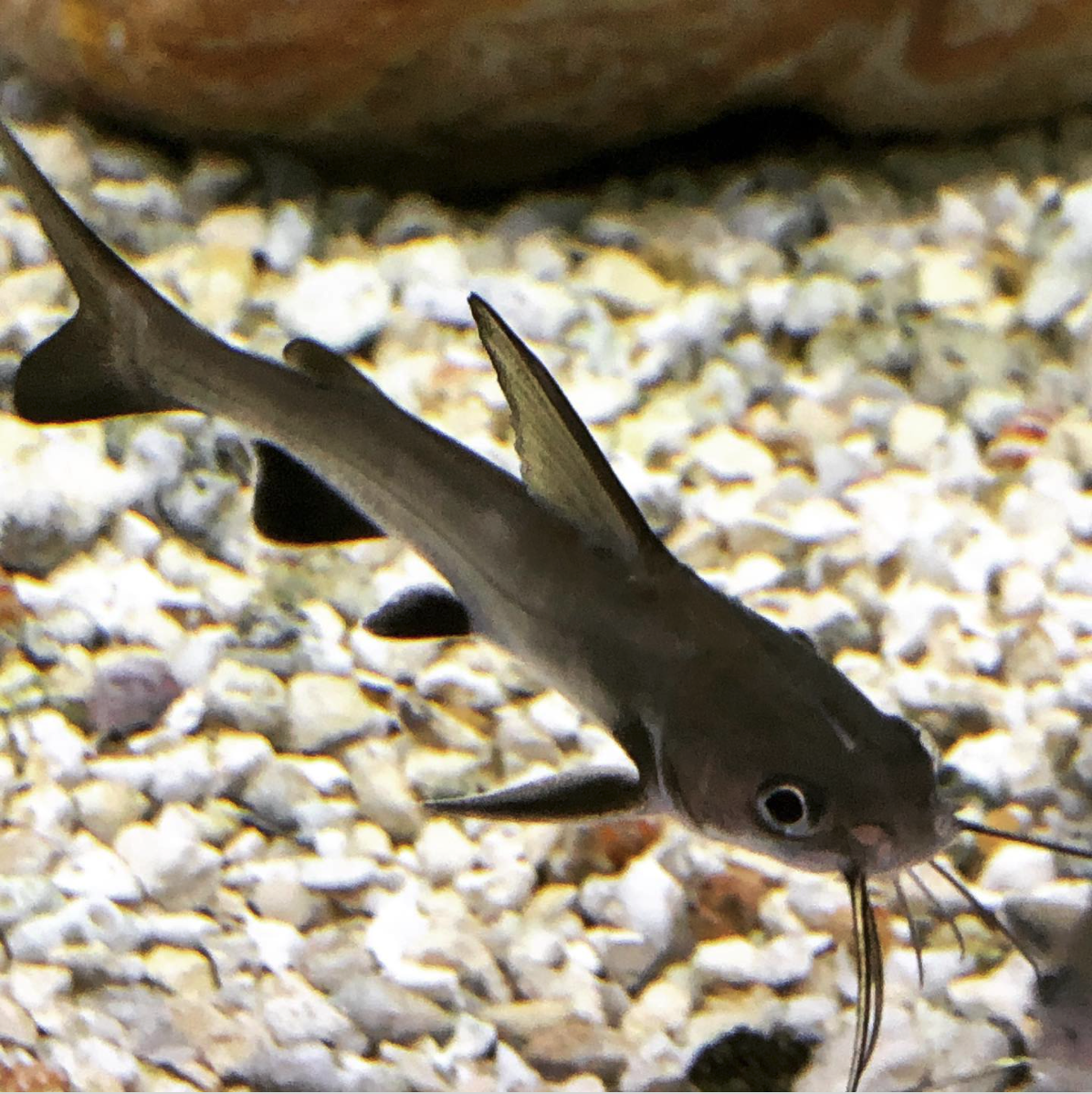
| Care level: | Temperament: | Color: | Lifespan: | Size: |
| Easy | Peaceful | Silver-gray | 10–15 years | 10–14 inches |
| Water temperature: | Water pH: | Tank size: | Diet: | Scientific name: |
| 75–80°F | 7.0–8.0 pH | 75 gallons | Omnivore | Arius jordani |
Columbian sharks are peaceful, predatory fish from the catfish family, originating from rivers and tributaries spanning across Mexico and the Gulf of California. Columbian sharks are favored amongst aquarists due to their peaceful natures and their cute appearance.
The columbian shark has a silver body with a white underside. The standout feature of this fish is the barbels, or whiskers, surrounding its mouth. Columbian sharks are schooling fish that spend most of their time scavenging the substrate for food.
House Columbian sharks with similarly-sized fish that have the same needs as Columbian sharks. The angelfish is a good choice for a Columbian shark’s tank mate.
In the wild, Columbian sharks begin their lives in freshwater, but move to saltwater as they grow — however, the fish have adapted to live their full lives in freshwater.
Chinese High-Fin Banded Shark
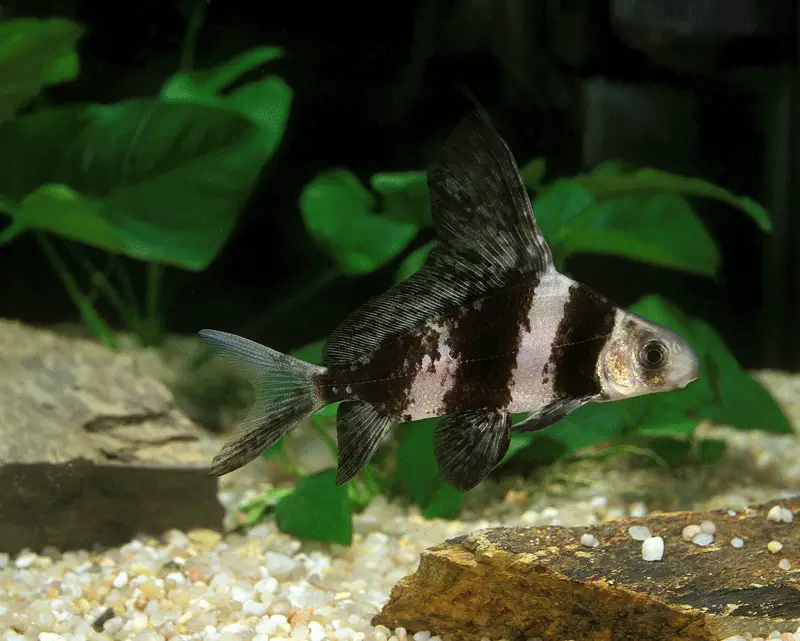
| Care level: | Temperament: | Color: | Lifespan: | Size: |
| Intermediate | Peaceful | White or brown with dark, slanting bands | 10–15 years | 24–50 inches |
| Water temperature: | Water pH: | Tank size: | Diet: | Scientific name: |
| 55–75°F | 6.0–7.5 pH | 300–800 gallons | Omnivore | Myxocyprinus asiaticus |
The Chinese high-fin banded shark is a freshwater shark that grows up to 50 inches, and is only suitable for fishkeepers with the space and budget for at least a 300-gallon tank.
Chinese high-fin banded sharks are from the sucker fish family, originating in cool, aerated fast-flowing rivers in North America and Russia.
The fish are a popular coolwater pond species and they get on well with most other fish. Chinese high-fin banded sharks have white or brown bodies with vertical slanted black stripes and black fins.
House Chinese high-fin banded sharks with koi fish, other Chinese high-fin banded sharks (groups of two or three), goldfish, and loaches, such as dojo loaches and hillstream loaches.
Choosing & Caring For Different Types of Freshwater Sharks
Freshwater sharks are a mixed batch of fish, with varying temperaments, colors, sizes, and lifespans. Read up on the individual freshwater shark you’re interested in to ensure that you can provide the right tank conditions for the fish to thrive.
Remember that many freshwater sharks are sold as juveniles, and the fish grow to double or triple their original size as adults. Make sure your tank is large enough for freshwater sharks, especially territorial species that need lots of swimming space.
When kept in the right environment, freshwater sharks are an entertaining, lively addition to any aquarium.
If you’re a beginner aquarist, choose a peaceful freshwater shark species, like Columbian sharks, bala sharks, and roseline sharks. Peaceful, similarly-sized freshwater sharks can be kept together, but housing aggressive or semi-aggressive sharks together will lead to fighting.
Breeding different types of freshwater sharks isn’t possible.

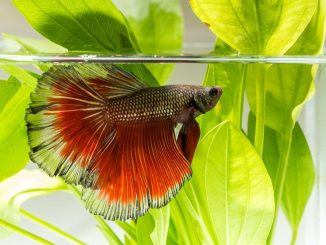
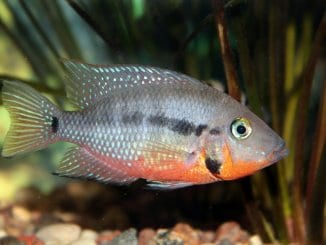
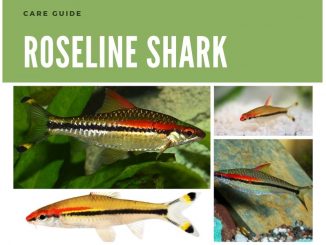
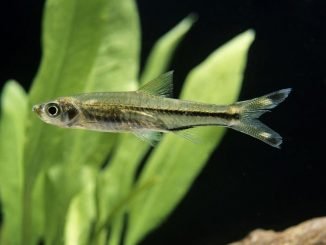

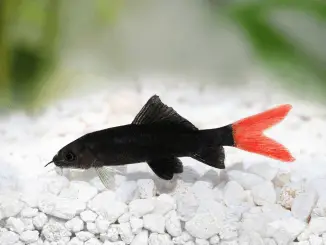
Be the first to comment